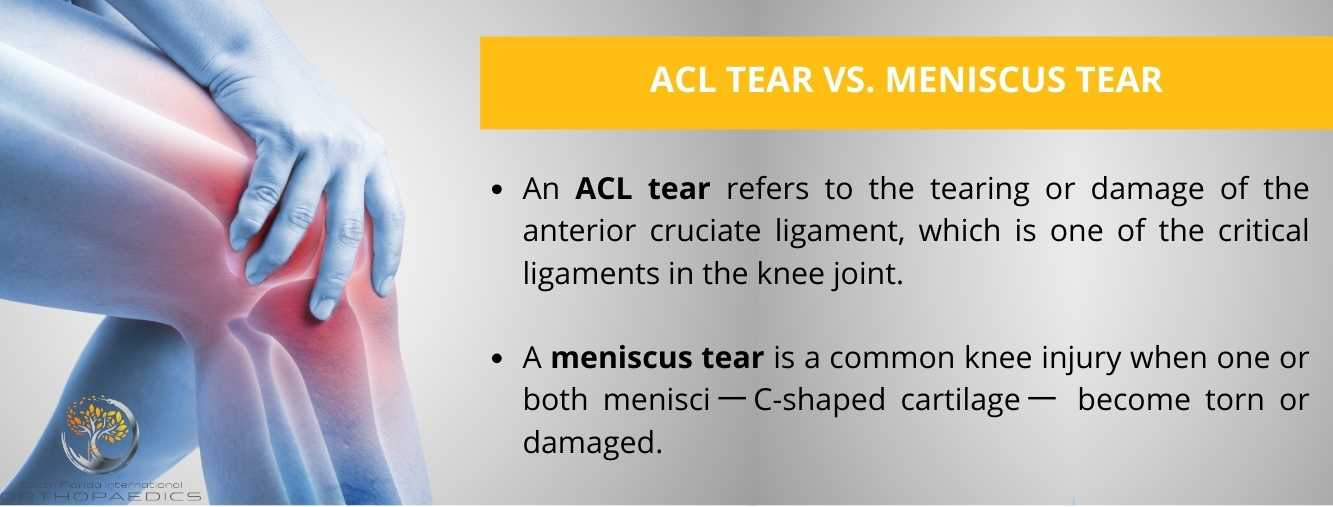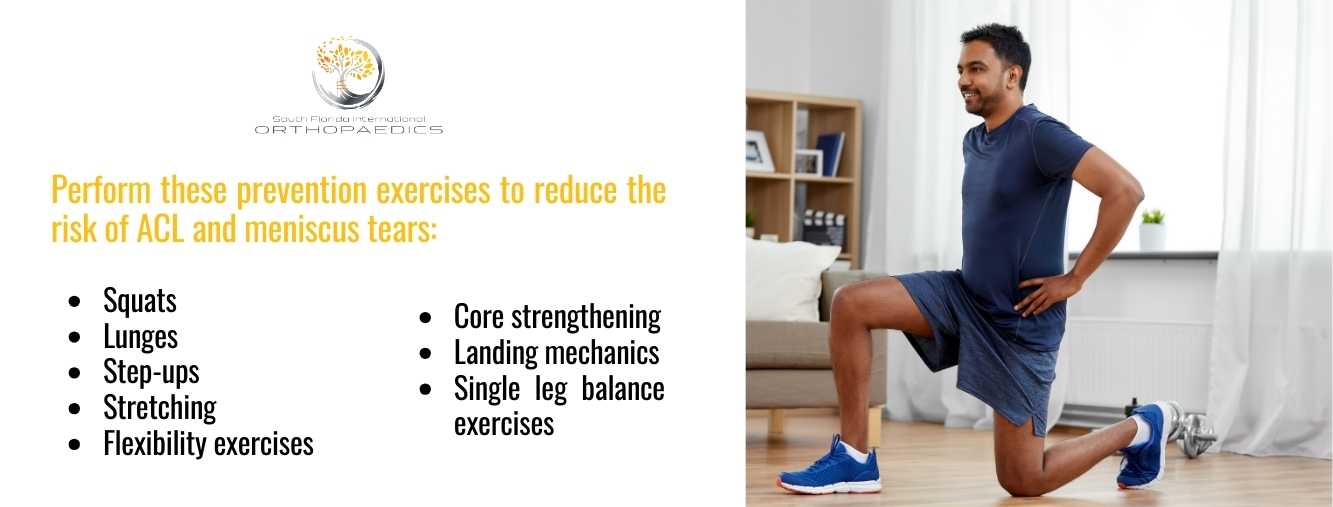In the world of sports, athletes often push their bodies to the limit, facing various challenges and obstacles along the way. One such obstacle that can be particularly daunting is the risk of meniscus and ACL tears. What exactly are these injuries, and how can athletes navigate them?

This comprehensive guide will answer these questions and give athletes the knowledge they need to effectively understand, prevent, and manage meniscus and ACL tears.
What is an ACL tear?
An ACL tear refers to the tearing or damage of the anterior cruciate ligament一one of the critical ligaments in the knee joint.
The ACL is a strong band of tissue that connects the thigh bone (femur) to the shinbone (tibia) and is situated deep within the knee joint. Its primary function is to provide stability to the knee by preventing excessive forward movement of the shinbone relative to the thigh bone.
ACL tears are relatively common, especially among athletes who engage in sports involving sudden stops, direction changes, or high-impact activities. These tears can occur due to various factors, including sudden twists, pivots, or direct blows to the knee.
What is a meniscus tear?
A meniscus tear is a common knee injury when one or both menisci一C-shaped cartilage一 become torn or damaged. The knee has two menisci, one on the inner side (medial meniscus) and one on the outer side (lateral meniscus). They serve several important functions:
- The menisci act as cushions or shock absorbers in the knee joint, helping to distribute weight and absorb impact during activities like walking, running, and jumping.
- They provide stability to the knee by improving the fit between the thigh bone (femur) and the shinbone (tibia), thus preventing excessive movement and reducing the risk of injury.
A meniscus tear can occur due to various factors, including sudden twisting or pivoting movements, direct trauma to the knee, or degeneration over time, especially in older individuals.
Athletes, particularly those involved in sports that require quick changes in direction, are at a higher risk of meniscus tears.
ACL tear vs. meniscus tear: Which is worse?
It’s important to note that ACL and meniscus tears can cause significant discomfort and limitations. Here’s a comparison to help you understand the differences:
| ACL Tear | Meniscus Tear | |
| Impact on stability | Significantly affects the knee joint stability. It often results in a feeling of the knee giving way or being unstable. | In most cases, it does not affect the knee joint’s stability. Individuals can still bear weight on the affected knee. |
| Recovery timeline | It involves extensive recovery that may take several months and long periods of rehabilitation. | Smaller tears only require a shorter recovery period, while severe ones need longer rehabilitation. |
| Surgical intervention | Complete ACL tears require surgical intervention. | Not all meniscus tears require surgery. Most tears can be treated using conservative approaches. |
ACL and meniscus tears can be painful and impact an individual’s ability to participate in sports and daily activities. However, the extent of the injury and the resulting limitations can vary.
What are the symptoms of a torn ACL?
A torn anterior cruciate ligament can cause a range of symptoms, and the severity of these symptoms can vary depending on the extent of the tear. Common symptoms of a torn ACL include:
- Immediate pain
- Swelling
- Instability
- Popping sensation
- Loss of range of motion
- Difficulty walking
- Tenderness of the affected area
What are the symptoms of a torn meniscus?
The symptoms of a meniscus tear can vary depending on the severity of the injury, but common signs include:
- Localized pain to the affected area of the knee.
- Swelling and stiffness in the knee.
- Limited range of motion.
- A popping or clicking sensation when moving the knee.
- A feeling of instability or “giving way” in the knee.
How are these injuries diagnosed?
Both ACL tears and meniscus tears are typically diagnosed through a combination of medical history, physical examination, and imaging studies.
Imaging studies are usually necessary to confirm the diagnosis and assess the extent of the ACL tear. Some examples include X-rays and magnetic resonance imaging or MRI.
What are the treatment options for ACL and meniscus tears?
The treatment options for ACL tears and meniscus tears can vary based on the severity of the injury, the individual’s activity level, and overall health. Here are the common treatment options for each:
Treatment for ACL tears
1. Non-surgical treatment
Physical therapy may be recommended for individuals with partial tears, low activity levels, or those who wish to avoid surgery.
Additionally, a knee brace may be prescribed to provide stability and support. This is often used temporarily, such as during the initial rehabilitation phase.

2. Surgical treatment
ACL reconstruction surgery is often recommended for individuals with complete ACL tears or those requiring total knee stability for high-demand activities.
During this procedure, the torn ACL is replaced with a graft (usually from the patient’s tissue or a donor). This surgery is followed by a comprehensive rehabilitation program.
Treatment for meniscus tears
1. Non-surgical treatment
Initially, following a meniscus tear, the RICE protocol is often recommended to reduce pain and swelling. Physical therapy can help improve knee strength, flexibility, and stability. It may be the primary treatment for more minor or less symptomatic meniscus tears.
2. Surgical treatment
In cases where non-surgical treatments are insufficient or for larger, more complex tears, arthroscopic surgery may be necessary.
During this minimally invasive procedure, the surgeon trims or repairs the damaged portion of the meniscus. The goal is to preserve as much healthy meniscus tissue as possible.
ACL tear and meniscus tear prevention exercises
Prevention exercises can play a crucial role in reducing the risk of ACL tears and meniscus tears. These exercises improve strength, balance, flexibility, and neuromuscular control in the knee and surrounding muscles.
Here are some effective exercises for ACL and meniscus tear prevention:
Squats
- Stand with your feet shoulder-width apart.
- Slowly bend your knees and hips to lower your body as if sitting in a chair.
- Keep your knees in line with your toes, and don’t let them collapse inward.
- Return to the starting position.
Lunges
- Step forward with one foot and lower your body until both knees are bent at a 90-degree angle.
- Keep your front knee in line with your ankle.
- Push off with your front foot to return to the starting position.
- Repeat on the other leg.
Step-ups
- Use a step or bench.
- Step up with one foot and straighten the leg.
- Lower yourself back down and repeat on the other leg.
- Focus on maintaining proper knee alignment.
Single-leg balance exercises
- Stand on one leg and balance for 30-60 seconds.
- Progress by closing your eyes or standing on an unstable surface.
- Perform on both legs to improve balance and stability.
Stretching and flexibility exercises
Stretching the quadriceps, hamstrings, and calf muscles can help maintain flexibility and prevent muscle imbalances.
Core strengthening.
Exercises to strengthen the core muscles, including the abdominals and lower back, help improve overall stability and reduce the risk of knee injuries.
Landing mechanics
Practice proper landing techniques when jumping and landing from a height. Focus on landing softly with bent knees and hips to absorb shock.
Where to find the best shoulder specialist in Miami?
Are you seeking world-class orthopedic care in South Florida? Look no further than South Florida International Orthopaedics! Our renowned team of orthopedic specialists is dedicated to providing you with the highest level of care and expertise.

From sports injuries to joint replacements, we offer a wide range of orthopedic services to treat different kinds of shoulder conditions, such as:
- Rotator cuff tear
- Labrum tear
- Frozen shoulder
- Shoulder dislocation
- Clavicle fracture
- Shoulder instability
- Shoulder arthritis
Whether you’re an athlete looking for the best Miami sports medicine or an individual seeking joint relief, we have you covered. We are committed to helping you regain mobility, alleviate pain, and improve your overall quality of life.
Contact us now at the Miami office (305) 233-0011 or the Homestead office (305) 247-1701 to get in touch with the best South Florida orthopedics team!
The material contained on this site is for informational purposes only and DOES NOT CONSTITUTE THE PROVIDING OF MEDICAL ADVICE, and is not intended to be a substitute for independent professional medical judgment, advice, diagnosis, or treatment. Always seek the advice of your physician or other qualified healthcare providers with any questions or concerns you may have regarding your health.
